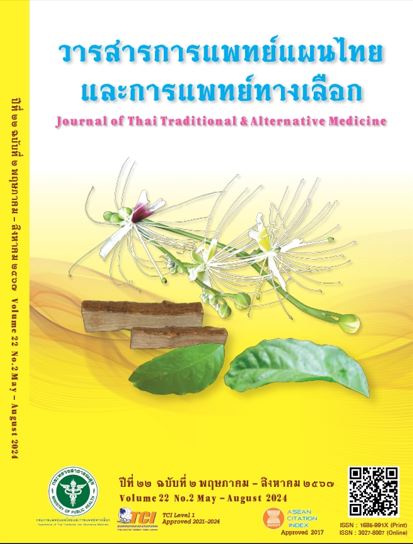Survey of Medicinal Plants in the Community Forest Area of Doi Hang Subdistrict, Mueang District, Chiang Rai Province for Use as a Source of Medicinal Raw Materials for Caring for the Health of the Elderly
Main Article Content
Abstract
Background: The Doi Hang Subdistrict has 17.67% of elderly people with health problems. The elderly have limited access to healthcare facilities because some villages are in remote areas. There is a community forest in the area, so it is necessary to explore medicinal plants in the community forest area to use as a source of medicinal raw materials for caring for the health of the elderly. This article aims to study medicinal plants in the community forest area of Doi Hang Subdistrict, Mueang District, Chiang Rai Province, for use as a source of medicinal raw materials for caring for the health of the elderly.
Methods: This research is a mixed methods research study using surveys and qualitative research. There were 8 key informants who were experts in local herbs, using a purposive selection method. The tools used in this research consisted of 2 parts: in-depth interviews and group meetings.
Results: It was found that there were more than 181 types of herbs in the Doi Hang Subdistrict. They were grouped into 6 types according to their use in Thai traditional medicine: (1) 73 types of trees, (2) 49 types of climbers, (3) 21 types of rhizomes, (4) 12 types of vegetables, (5) 15 types of grasses, and (6) 6 types of vegetation, which encourage the elderly to use herbs to take care of their health. They are herbs that are easily available in the local area and have convenient methods of use, divided into 5 groups of herbs to cure symptoms according to disease groups as follows: (1) 7 types of herbs to cure symptoms of skin diseases, (2) 14 types of herbs to relieve symptoms of gastrointestinal diseases, (3) 9 types of herbs to relieve symptoms of respiratory diseases, (4) 1 type of herb to relieve symptoms of structural, joint, muscle, and tendon diseases, and (5) 2 types of herbs to relieve symptoms of wind disease.
Discuss the results: The survey of medicinal plants in the community forest area of Doi Hang Subdistrict found that there are local medicinal plants. That has the opportunity to be used to care for the health of the elderly, which encouraged people to be self-reliant, reduced health expenses and was a source of herbal raw materials to generate income from selling herbal raw materials to the elderly in the community.
Conclusions and recommendations: This research study is a survey of medicinal plants in the area of Doi Hang Subdistrict. The medicinal plants surveyed are local herbs. If the study results are used, they should be adjusted to suit the illness context of the people in the area. In the next research study, there should be a follow-up on the results of promoting health care for the elderly with herbs in the Doi Hang Subdistrict and used to develop guidelines for promoting health care for the elderly with herbs.
Article Details

This work is licensed under a Creative Commons Attribution-NonCommercial-NoDerivatives 4.0 International License.
References
Institute for Population and Social Research Mahidol University. Population of Thailand 2023. Population Bulletin Mahidol University. 2023; 32(1): 1-2. (in Thai)
Department of Older Persons. Situation of the Elderly 2022. Bangkok: Amarin Corporation Public Company Limited; 2023. 105. (in Thai)
The Bureau of Registration Administration. [Internet]. Population statistics by age, data for 2022, area: Doi Hang Subdistrict, Mueang Chiang Rai District Chiang Rai Province; c2022 [cited 2022 November 11]. Available from: https://stat.bora.dopa.go.th/stat/statnew/statyear/?fbclid=IwAR0kcJsqq1fO_ZEtmzy_mRCE6dBuRgd1HEzCHEzCkRhE0hj35WUsPpN95ss#/TableAge. (in Thai)
Ministry of Public Health and government-private organizations. National Master Plan for the Development of Thai Herbs, No. 1, 2017 – 2021. Samut Prakan: TS Interprint Co., Ltd.; 2016. 176. (in Thai)
PhilawanN, Khanaree C, Mainon N andTongthongK. The Surveyof Community Forest for TheOpportunity of Medicinal PlantCultivation: a case Study of BanHuafai Community Forest inBanduDistric, Chiang Rai Province. Udon Thani Rajabhat University Journalof Humanities and Social Science 2022; 11(2): 83-96. (In Thai)
Kawjai P, JantawongN, TaoprasertYand Ruancharoen C. Potential Development of Medicinal Plants for Elderly Healthcare. Journal of Community Development and Life Quality 2022; 10(3): 293-301. (In Thai)
Kaewjantha S, Wiriya S, WailapeeC,Seawang Cand Chaiwong N. Guidelines for taking care of health care and improving the quality of life for the elderly with herbs in Boon Rueang Sub-district, Chiang Khong District, Chiang Rai.Journal of Management and Local Innovation 2023; 5(6): 121-135. (In Thai)
PhatthajarP, SophonphatthanabandiP, Lanwong Aand Sarutisut T. The Health Promotion with Buddhist Herbs of Nak-Wichai Community, Talat Sub-District, Muang Mahasarakham District, Mahasarakham Province. Journal ofPhimoldhammaReseach Institute 2023; 10(1): 174-183. (In Thai)
Juntawong N, Mama R, Sae-wang C, Tansuwanwong S and Ruancharoen C. The Development of Health Self-Reliance Innovation with Basic Handy Herbs for the Elderly. Journal of MCU Social Science Review 2021; 10(1): 245-256. (In Thai)
Jungsomjatepaisal P. Development of a Prototype for Promoting the Use of Herbal Medicine in Households in Thailand. Journal of Health Science 2019; 28(6): 1092-1103. (In Thai)


